The Village of Dunlop
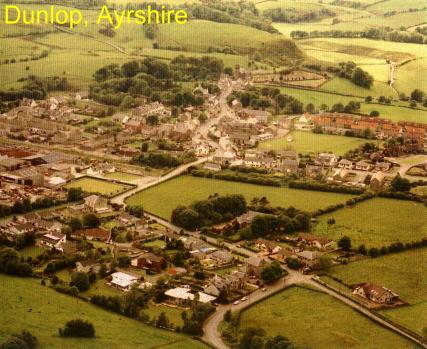
Note the Dunlop hill at top of photo, then the Kirk at top
center...follow main street towards you. Struther Farm House is in the Center in
the trees, and the rectangular enclosure to the left is the Bowling Club. The
Dunlop House is off the Photo's bottom about a mile.
updated
10.21.2019
The Village of Dunlop has
posted a new website which has linked our site to theirs!
see it at
www.dunlopvillage.co.uk

History
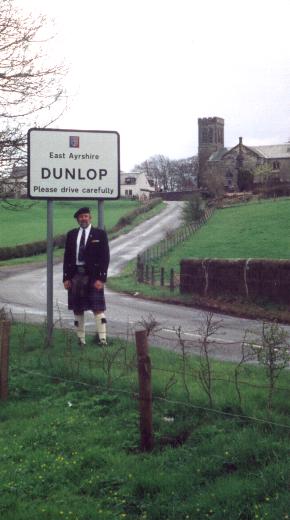 Dunlop is situated in the extreme north of Ayrshire
bordering Renfrewshire and stands 400 to 500 feet above sea level, seven and a
half miles from Kilmarnock and sixteen and a half miles from Glasgow.
Dunlop is situated in the extreme north of Ayrshire
bordering Renfrewshire and stands 400 to 500 feet above sea level, seven and a
half miles from Kilmarnock and sixteen and a half miles from Glasgow.
Dunlop Maps


By now you know how the Village got it's name: The Celts
who occupied the area named it Dun (fort) Lop (at the bend or winding) because
of the strategic placement of the stronghold at the winding of the burn (stream)
Glazert around Dunlop Hill.
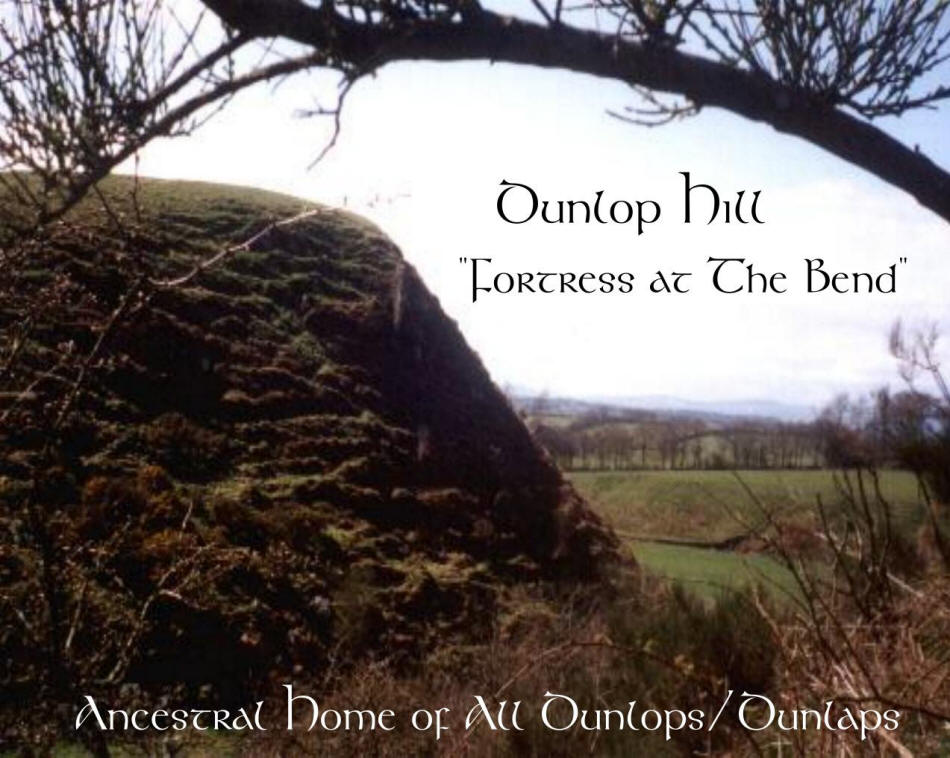
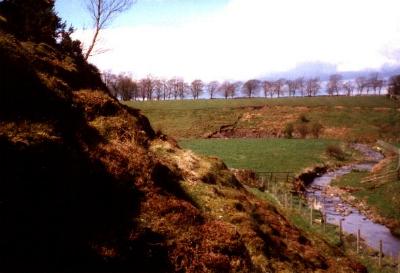

In the latter half of the Sixth century four
races disputed possession of this land area. They were the Picts, Britons (Brythonic
Celts), Scots or Gaels (Goidolic Celts), and the Angles. The race which occupied Cunninghame, the part of Ayrshire which includes Dunlop, were the Brythonic
Celts. These Celts held Dunlop Hill. This area did exchange hands between the
Brythonic (Britons of Strathclyde) Celts and the Goidolic (Scots of
DalRiada)Celts in the 5th and 6th Centuries. There is considerable speculation
that the Romans used Dunlop Hill in the first Century
(82AD) as a communications
outpost in preparation for Agricola's planned invasion of Ireland, which never
occurred. The Picts were there before Fergus Mac Erc of DalRiada, the Angles
came through occasionally, and the Vikings were known to have sent foraging
parties inland. In other words, it was a dangerous place to live.
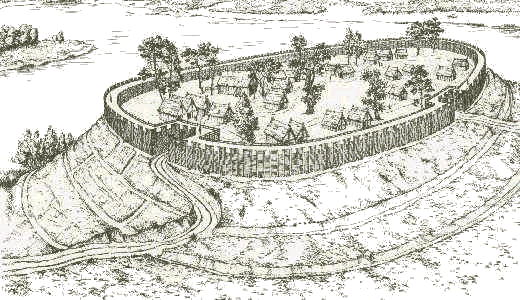

The early Celts in this area lived on and
around Dunlop Hill and worshipped with the Druids.
Scholars report that Celts belonging to the Damnoni and the Selgovae tribes
lived in this area of Scotland. See the Damnoni sites:
Damnoni
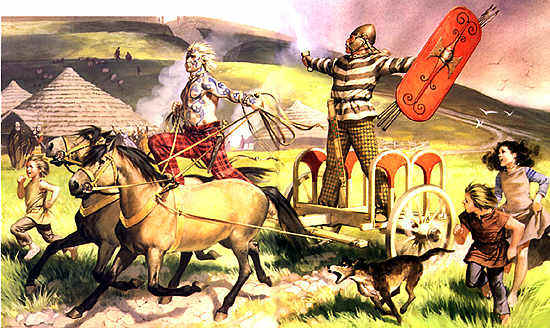
"In the north of Britain, there were three
major tribes in the Lowlands: the Votadini in the Edinburgh and Lothian area,
the Novantae in Dumfries in Galloway in the Southwest, and in between them the
Selgovae. In addition to these there were northern Scottish tribes, all called
Caledonii by the Romans: the Vacomagi in Angus, the Taezali of Buchan, the
Decantae of Ross, and the Lugi of Caithness. Dwelling in the Northwest were the
savage and fearsome Cereni, Smertae and Carnonacae, who were said to smear their
faces with the blood of the slain. The Damnonii were situated near the Firth of
Clyde. Certainly other northerly tribes, without Roman names, existed as well,
but the Romans collectively called all of these Caledonians.
There is little doubt that these Caledonii
were various Pictish tribes, probably before they were unified as one
identifiable people." from Robert M Gunn
"In
the area we now call southern Scotland were a number of tribes which included
the Votadini, the Novantae, the Selgovae and the Damnonii. The Votadini lived in
the eastern coastal regions and between the Tyne and the Clyde, the Novantae in
the area of Galloway and Dumfriesshire, the south- west, while the Selgovae
occupied the area between them. Further north were the lands of the Damnonii.
These people were to come into contact with the Romans during the period when
the Antonine Wall was the northern Roman frontier and at other times when they
traded and seemed to have some sort of political agreement with the
Romano-British government." from Ron Wilcox
From Caesar to Cladius
Within a half mile of the Hill is a
twenty-five ton stone measuring twelve foot by eight which is called the "Ogirtstane".
It was believed to be used as a Druid Altar and as possibly a place of
cremation. In the area of Lugton in Dunlop Parish there is Law Hill. Around it
is set a series of Standing Stones at regular intervals and at equal distances
from the summit. the Stones encircled the Area where "refuge was secure and
justice impartially given". This area served as the Court of Justice for the
DunLop tribe.

Gnaeus Julius Agricola was a Roman general
and governor of the province of Britannia from 78-84AD. He is credited with overseeing the final conquest of Britain.
overseeing the final conquest of Britain.
In a series of annual military campaigns Agricola put down
revolts in north Wales, subdued the Brigantes tribe in the north, extended Roman
control over the Scottish lowlands, where he established a string of forts
between the Forth and the Clyde, sent troops into Galloway, and made inroads
into the eastern Highlands. During the latter campaign his vessels were the
first to circumnavigate the islands. In 83 or 84AD Agricola met the
Caledonian war leader Calgacus in a major battle at Mons Graupius.
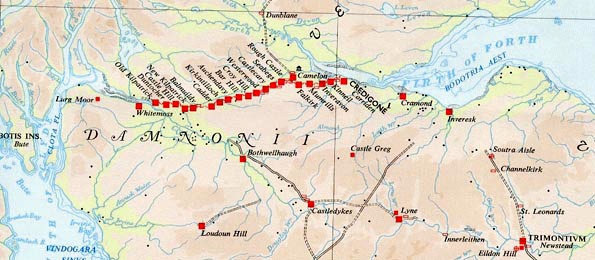
The Romans occupied Dunlop Hill for a short time (82 CE),
in their normal fashion of using a local strong place, when Agricola advanced
through Galway and Ayrshire, to guard the line of communication between Carlisle
and Dumbarton. After the Romans left the area, the Dunlop Celts were
alternatively ruled by the nearby Kingdom of British Strathclyde and the Irish
Kingdom of Dalriada. Some is now known about Strathclyde. Dalriada was
expanded to the now Scottish soil by the banished Irish King Colla da Crioch in
327 AD. The 350 Irish clans who came with him were called "Scotti" , which
translates as "plunderers", or "bandits". King Fergus Mac Erc moved the capital
of Dalriada to Scotland at Dunadd in the fifth Century AD. The DalRiadians
established themselves in the Ayrshire district circa 490's AD. They called
themselves "Gaels" but were always referred to as "Scots", from the Milesian
story of Scotia, mother of the Irish.

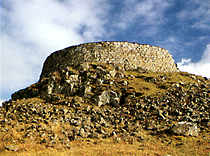 The
fortified citadels of Dalriada were clearly linked with outlying smaller
farmsteads, most notably the Duns and crannogs. The
Duns are regarded as the
seats of men of varying social standing who were subject to the overlordship of
the Rulers of the four great strongholds: Dun Ollaigh, Dunadd, Tairpirt Boittir,
and Aberte. DunLop was one of these lesser seats of authority. Below these Duns
were farmers of lesser status who came under the authority of the Dun occupiers.
The
fortified citadels of Dalriada were clearly linked with outlying smaller
farmsteads, most notably the Duns and crannogs. The
Duns are regarded as the
seats of men of varying social standing who were subject to the overlordship of
the Rulers of the four great strongholds: Dun Ollaigh, Dunadd, Tairpirt Boittir,
and Aberte. DunLop was one of these lesser seats of authority. Below these Duns
were farmers of lesser status who came under the authority of the Dun occupiers.

The Power to the East were the Picti, or "Painted Ones",
called so by the Romans, who left Britain in the year 407. The Romans had moved
into Ayrshire, in 82 CE, with a fort at Loudoun Hill, and the temporary post at
Dunlop, in anticipation of an invasion of Ireland by Agricola that never
occurred. One of the reasons the Irish moved into Argyll was that it was left
undefended by the Romans, and after the Romans departed, western Scotland was
open to the Irish for the taking.

Post Roman
Strathclyde and DalRiada
After the collapse of the Roman Empire it withdrew from
Britannia in 409 c.e. At this point, the Picts of Caledonia became restless and
fought and raided the lands south of Hadrian's wall. The Britons and the Saxons,
a Germanic tribe, fought off the Pictish threat and eventually the Saxons
invaded and emigrated to southern Britannia in great numbers, forcing the
Britons northwards into southern Caledonia, where the Britannic Kingdom of
Strathclyde was formed.
Meanwhile neighboring kingdoms were established. In the
early 6th century, the Scotti tribe (Scots), the Celtic peoples of Northern
Ireland, came to Britannia to establish the Kingdom of Dalriada. Later in the
century the Angles, a Germanic people similar to the Saxons took all the lands
south of the River Forth (Firth of Forth being the estuary) and with parts of
northern England established the Kingdom of Northumbria. The Picts were again
forced into a kingdom in the north.
In 730 Angus Mac Fergus, the Pictish King took Strathclyde
and the Scot's Kingdom of Dalriada. Peace followed until the Scandinavian
Vikings started troubling Pictish coasts. While the Pictish armies concentrated
on external security, the Scots and the Britons managed
to eject the occupying forces.
Kenneth Mac Alpine, King of the Scots was crowned King of
the Picts in 844. Together these lands formed the new Kingdom of Alba.
In 878 the Britons, in an act of revenge, forced the house
of Mac Alpine from the Kingship of Pictland, however, in 889 they returned and
invaded .
For the Britons this may have been a disaster. The
following year, Welsh sources note, the men of Strathclyde who didn't accept the
new order, went into exile and settled in Gwynedd (or Wales). Following this
exodus, Strathclyde seems to have become a sub-kingdom of the
new Pictish and Gaelic Kingdom of Alba, with its royal line related to the Kings
of Alba.
The last king of Strathclyde, Owein the Bald, died fighting
for Malcolm II, King of Alba, at the Battle of Carham.
The Picts were assimilated into the Scot culture, losing
their language to the Gaels, and essentially their existence. McAlpin is
considered the first King of Scotland. He moved the Capital to the ancient
Pictish seat of power, named Scone, and with him brought the famous Stone from
Dunadd. The Briton Kingdom of Strathclyde was annexed in 900, then Malcolm II
secured the Kingdom of Lothian in 950. "Modern" Scotland was born when the
treaty of Perth reclaimed from Norway the Northern territories (took by Vikings
over a period of 400 years) which were annexed into "Scotland" in 1266.

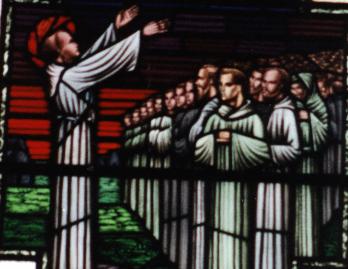 In
the early 6th Century the Christian missionary St Finbar (Finnian to
the Irish, to the Britons Winnan, died 579) established a settlement
in Cunninghame at Kilwinning (Kirk of Winnan). Dunlop was within the sphere of
his work and conjecture is that Finian converted the Chief of Dunlop. "He was
an Irish abbot, a disciple of Sts. Colman and Mochae also called Winin. He was
born in Strangford, Lough, Ulster, in Ireland, a member of a royal family.
Studying under Sts. Colman and Mochae, he became a monk in Strathclyde and was
ordained in Rome. Returning to Ulster, Finian founded several monasteries,
becoming abbot of Moville, in County Down, Ireland. He became embroiled with St.
Columba, a student, over a copy of St. Jerome�s Psalter, and St. Columba had to
surrender that copy to Finian. He also founded Holywood and Dumfries in
Scotland. Finian was known for miracles, including moving a river."
from the
Catholic Saints Online
In
the early 6th Century the Christian missionary St Finbar (Finnian to
the Irish, to the Britons Winnan, died 579) established a settlement
in Cunninghame at Kilwinning (Kirk of Winnan). Dunlop was within the sphere of
his work and conjecture is that Finian converted the Chief of Dunlop. "He was
an Irish abbot, a disciple of Sts. Colman and Mochae also called Winin. He was
born in Strangford, Lough, Ulster, in Ireland, a member of a royal family.
Studying under Sts. Colman and Mochae, he became a monk in Strathclyde and was
ordained in Rome. Returning to Ulster, Finian founded several monasteries,
becoming abbot of Moville, in County Down, Ireland. He became embroiled with St.
Columba, a student, over a copy of St. Jerome�s Psalter, and St. Columba had to
surrender that copy to Finian. He also founded Holywood and Dumfries in
Scotland. Finian was known for miracles, including moving a river."
from the
Catholic Saints Online
The Celts easily made the transformation from
Druidry to Christianity because of the many similarities and because the Celtic
missionaries wisely used the local sacred places and holidays as their own.
Close by are the Chapel Crags where the Druids lived, and near to that a sacred
well whose water possessed miraculous properties. As the Christians did
everywhere in the Isles, they overlaid existing sacred places with their own,
and today this well is still known as St Mary's Well. The baptism water used at
Dunlop Kirk is still drawn there today. The first Christian place of worship,
Lady Chapel, was built on that site.
The Kirk was built at the junction of three
Burns near Townfoot.
See
Dunlop Kirk

Up until the 11th century, the Celtic Chief on
Dunlop Hill ruled his country as his fathers before him, and called himself
"Dunlop of Dunlop". The Celtic families had tiny crofts which provided them with
all their requirements, and there was no reason to leave. There were a few cows
of a very rough type bred locally, for there was little or no communication
between neighboring tribes, except in time of war. This changed drastically when
the Alban (Scottish-Pict)King Malcolm II (1005-1034) annexed the Briton kingdom
of Strathclyde (including Dunlop),
essentially creating what is now known as Scotland. Now a succession of
Normanized Kings began to rule over all other forces and to establish feudalism
in the country. The apportioning of the country, started by Malcolm II, was
continued by David. It was King David (1124-1153) who granted the district of
Cunninghame (including Dunlop) to de Morville who was appointed Hereditary
Constable. (A Hugo de Morville is buried under the aisle of the Mosque of el-Aksa
in Jerusalem). In his time the Celtic Chiefs, including Dunlop of Dunlop became
Earls or Thanes, and ownership of the land passed to the Crown.
reason to leave. There were a few cows
of a very rough type bred locally, for there was little or no communication
between neighboring tribes, except in time of war. This changed drastically when
the Alban (Scottish-Pict)King Malcolm II (1005-1034) annexed the Briton kingdom
of Strathclyde (including Dunlop),
essentially creating what is now known as Scotland. Now a succession of
Normanized Kings began to rule over all other forces and to establish feudalism
in the country. The apportioning of the country, started by Malcolm II, was
continued by David. It was King David (1124-1153) who granted the district of
Cunninghame (including Dunlop) to de Morville who was appointed Hereditary
Constable. (A Hugo de Morville is buried under the aisle of the Mosque of el-Aksa
in Jerusalem). In his time the Celtic Chiefs, including Dunlop of Dunlop became
Earls or Thanes, and ownership of the land passed to the Crown.

Cunninghame was very much a rural area in Norman and
Medieval times, and there was very little trade. Markets were held in
neighboring parishes, but they were mainly livestock markets. Because Dunlop was
so rural , it is hardly ever mentioned, except for the Kirk. The simple farm
life stayed the same for centuries. The development of the area did not occur
until the mid eighteenth century.

The principal produce of the Parish of Dunlop was cheese.
This was a whole milk cheese, and when it was introduced to Scotland it was
completely new as before all cheese had been made with skimmed milk. It is still
currently known as "Dunlop Cheese". During the turbulent years after 1660, a
farmers wife named
Barbara Gilmour fled from Dunlop to Ireland and there learned the art of
making whole milk cheese. Eventually, after the
Revolution of 1688, she returned to Dunlop, to the farm now known as the "Hill",
bringing the recipe for the cheese. It proved tremendously popular and soon she
was teaching her neighbors. "Knowing" that cheese could not be made from whole
milk, the locals almost accused her of witchcraft at the Cross of Irvine. Some
others accused her of copying their recipes. "What remains beyond doubt, is the
pioneering work of Barbara Gilmour did by developing the making of sweet cream
cheese, later called Dunlop. Assuming her return after the Revolution of 1688,
she married Mr. John Dunlop of The Hill Farm at Dunlop. Something of an
evangelist in the matter of making sweet milk (unskimmed milk) cheese, she must
have been a forthright and energetic character who traveled widely to teach the
making of Dunlop cheese, and so developed a nation-wide demand. This demand
stimulated merchants to visit Cunningham, buy Dunlop cheese and sell it
throughout the central lowlands of Scotland. Her system for making Dunlop was
widely copied and extended rapidly to many all parts of Scotland by the end of
the 18th century, even where traditionally sheep's milk cheese had been made." "...from "Cheesemaking in
Scotland" John Smith". Not long after a new
and prosperous body came into being, namely the cheese merchants who took cheese
to Paisley and Glasgow. Barbara's cheese press can still be seen today at the
"Hill" (left). Buy Dunlop Cheese
here.
Smith, John. Cheesemaking in Scotland - A History. Scottish Dairy
Association

The year 1723 saw the beginning of the "Ayrshire
Improvers". The land was in very poor state and there was hardly a practicable
road in the county. Despite the agricultural revolution improvements did not
reach Cunninghame until 1780. Alexander, Earl of Eglinton was the first to
reclaim his lands. He introduced crop rotation, his cattle were improved, trees
planted, lands drained, and the ground fed, leveled and straightened. His
improvements affected the value of his land by 1,500% by the time he was
finished.
The farming pattern then improved rapidly and Dunlop was
again about to make its mark upon Scotland. 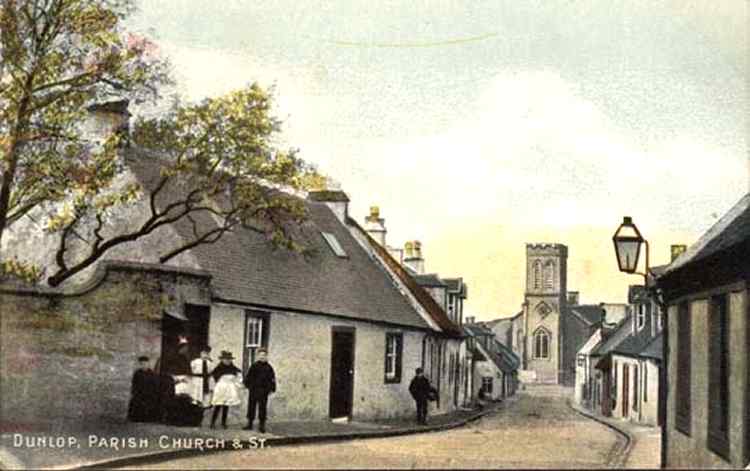
"It has been claimed that the Ayrshire cow was first bred
at one of the home farms of Mr. J. Dunlop, Titwood, about 1793 when the
Kilmarnock Club for Ayrshire Cattle was formed. This farmer was recognized as
one of the most notable of the early breeders in the region. The first Ayrshires
were bred by crossing the local type of Highland cow which came from Carrick and
an unknown imported Dutch bull. This breed had the names Dunlop cow, afterwards
the Cunningham cow and later Ayrshire cow.
Robert Burns also played his part in the introduction of
the Ayrshire to Galloway. Writing in 1788 to Mrs. J. Dunlop of Dunlop he
expressed gratitude on receiving as a present from her husband "the finest quey
in Ayrshire".
Mr. Aiton asserted that for many years past the breed had
been introduced into every county in Scotland, and into many of these in England
(McQueen, 1961). However, the peripatetic Mr. W. Cobbett on a visit to Scotland
in 1832 went so far as to purchase an Ayrshire bull and ten cows for his farm
near London where he felt "they will be worth a Kentish or a Sussex farmers'
going fifty miles to see".
The 19th century was a period of much breeding and
selection by farmers leading to the development of the characteristic elongated
udder in Ayrshire cows which distinguishes it from other breeds. It was,
however, often considered useful as a dual purpose animal when its propensities
as an excellent forager and high milk yielder became apparent. Thus, it was
often crossed with other breeds such as the Galloway which eased its
introduction into the Solway counties and with it cheese making on a large scale
for the first time."...from "Cheesemaking in Scotland" John Smith"
The breed was then exported all over the world. The first
importations of Ayrshires to the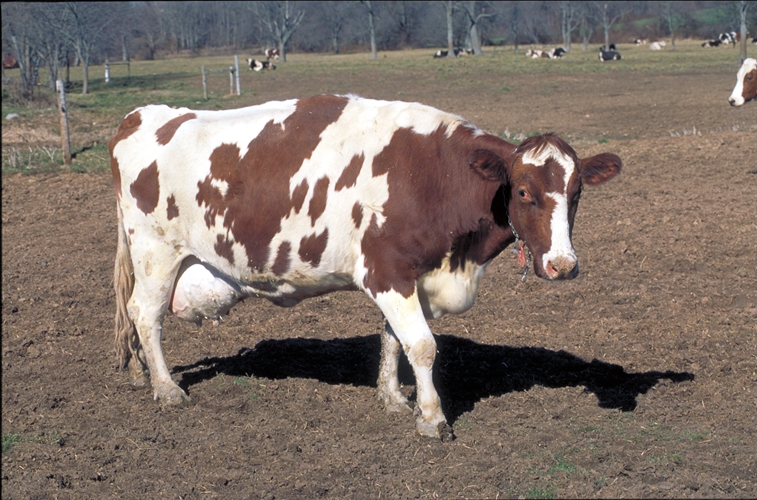 United States was believed to have been made around 1822. Farmers in New England
needed a dairy cow that would graze the pastures of their rough, rocky farms and
tolerate the cold, often inhospitable winters. In many ways, the environment
in New England was very similar to the Ayrshire's native Scotland, and she
thrived in her new home. Even today, the Ayrshire is very popular in New
England, but her popularity has spread and the Ayrshire herds are now located in
every part of the United States.
United States was believed to have been made around 1822. Farmers in New England
needed a dairy cow that would graze the pastures of their rough, rocky farms and
tolerate the cold, often inhospitable winters. In many ways, the environment
in New England was very similar to the Ayrshire's native Scotland, and she
thrived in her new home. Even today, the Ayrshire is very popular in New
England, but her popularity has spread and the Ayrshire herds are now located in
every part of the United States.
The Ayrshire cow is universally recognized as one of the most beautiful of the
dairy cattle breeds, but much more important is the fact that this breed is
highly regarded for its milk producing abilities, and is recognized throughout
today's world as THE dairy cow.

Other industries started to make their way
into Dunlop. In 1791 there were six masons, twelve weavers, three smiths, three
shoemakers, four tailors and three inn-keepers. in 1823 "Mackie's Mill" was set
up on the banks of the Glazert and started to produce woolen blankets. In 1849
Mr. Wilson set up shop as a ham curer and became very prosperous. the original
curing house , known as the "Burnhouse" has been landscaped and transformed by
his grandsons into a local park. In 1857, Robert Howie and sons started a small
meal-mill, added a sawmill, and was the first to use steam power locally.
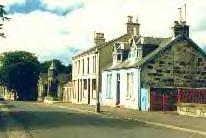
The end of the 19th century brought the railway into
Dunlop, which increased trade and put us in touch with Glasgow. Because of this
the farmers began sending their milk directly into Glasgow, which resulted in
the decline of cheese making in Dunlop...Dunlop cheese was and is made now at
Kilmaurs Creamery a few miles outside of Glasgow. The rail also precipitated the
move of Robert Howie and sons closer to the rail, where they remain still today.
the 1930's saw the expansion of Wilson's ham business, which had by now branched
into Ireland. By 1939 Mackie's Mill was producing carpet yarn and branched into
two more sites. By 1950 the village had quite a few new shops....a post , four
grocers, one baker, a news outlet, one hotel, and a public House. The Wilson's
started and sold a pet food business, making them one of the foremost families
in Dunlop. The Dunlop hosiery Co started and is now a prosperous concern. Photo
courtesy of Martin Galloway, resident of Dunlop from 1960-1988, now living in
Toronto, Canada.
When
you visit, stop and see Norman Neilson at the Cross Newsagents
store. Read Martin Galloway's article about Norm here.
c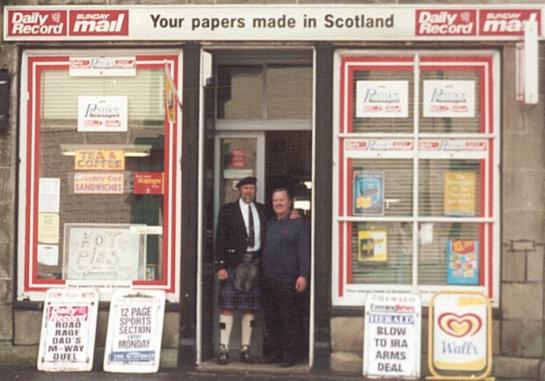
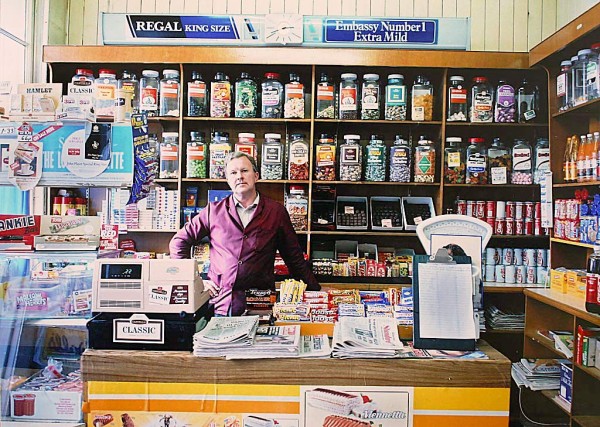
Stop and see the Wilson's at the Struther
farm house B&B.
Say hi to Vicar Maureen
Duncan at the renovated Dunlop Kirk.
Then have a pint at the
Village Inn.
Tell them
Mike Dunlap of Florida
sent you.
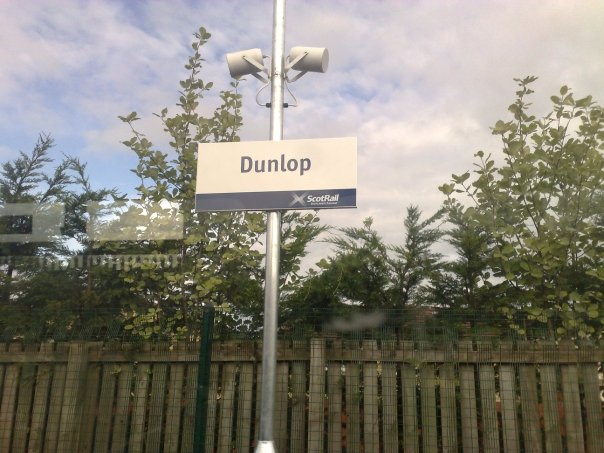
Pic taken by Scott Clark 7/15/09


Farming is still a mainstay of the locals, but most of it
is used to feed the cattle. As Dunlop is mainly a dairy farming area the most
notable improvements are those connected with milking of the cows and milk
production. The Parish of Dunlop is today a thriving community which has
survived many calamities, wars, and poverty, much as any other small Scottish
community.
As before, the Celtic families have their small farms or
holdings, and live in peace unless threatened, whether by the Picts or the
English, the Vikings or a Church, the Germans or the Communists, or Ourselves.
The Celts were here since the 4th century
BCE, and here they remain.
"Merito!"

See East Ayrshire Council
Dunlop History
The Village of Dunlop has
posted a new website which has linked our site to theirs!
see it at
www.dunlopvillage.co.uk
Pubs:
Name:
The Auld Hoose
Address: 68, Main St, Dunlop, Kilmarnock, Ayrshire, KA3 4AG
[01560 484951]
Name:
Merito Pub
Address: 2-6 Stewarton Rd, Dunlop, Kilmarnock, Ayrshire, KA3 4AA
[01560 482920]
Sources:
The
Statistical Account of Scotland,
(use non-academic access) 1791
The New Statistical Account of Scotland,
1845
The Third Statistical Account of
Scotland: Ayrshire, 1951
Archibald Dunlop, Dunlop of that Ilk,
Glasgow, 1898
Rev James Hanna,
The House of Dunlap, 1956,
Michigan
Freda White,
The House of Dunlop, 1951, Oakland, Ca
Jennifer Hutchison, History and Economic
Development of the Village of Dunlop,1972, Edinburgh
Susan Milligan, Old Stewarton, Dunlop and
Lugton, 2001, Ayrshire
Dugald Campbell, ed., Dunlop Ancient and
Modern Exhibition, 1998, Dunlop
Mike Dunlap, personal photos and interviews
with the fine people of Dunlop
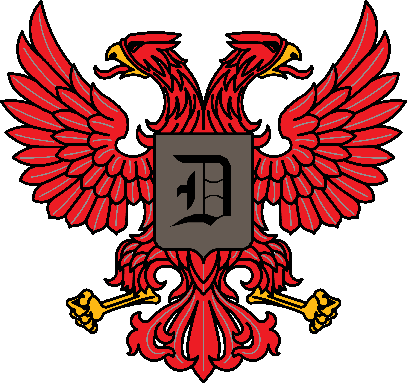
![]()
 Dunlop is situated in the extreme north of Ayrshire
bordering Renfrewshire and stands 400 to 500 feet above sea level, seven and a
half miles from Kilmarnock and sixteen and a half miles from Glasgow.
Dunlop is situated in the extreme north of Ayrshire
bordering Renfrewshire and stands 400 to 500 feet above sea level, seven and a
half miles from Kilmarnock and sixteen and a half miles from Glasgow.





 overseeing the final conquest of Britain.
overseeing the final conquest of Britain.
 The
fortified citadels of Dalriada were clearly linked with outlying smaller
farmsteads, most notably the Duns and crannogs. The
The
fortified citadels of Dalriada were clearly linked with outlying smaller
farmsteads, most notably the Duns and crannogs. The
 reason to leave. There were a few cows
of a very rough type bred locally, for there was little or no communication
between neighboring tribes, except in time of war. This changed drastically when
the Alban (Scottish-Pict)King Malcolm II (1005-1034) annexed the Briton kingdom
of Strathclyde (including Dunlop),
essentially creating what is now known as Scotland. Now a succession of
Normanized Kings began to rule over all other forces and to establish feudalism
in the country. The apportioning of the country, started by Malcolm II, was
continued by David. It was King David (1124-1153) who granted the district of
Cunninghame (including Dunlop) to de Morville who was appointed Hereditary
Constable. (A Hugo de Morville is buried under the aisle of the Mosque of el-Aksa
in Jerusalem). In his time the Celtic Chiefs, including Dunlop of Dunlop became
Earls or Thanes, and ownership of the land passed to the Crown.
reason to leave. There were a few cows
of a very rough type bred locally, for there was little or no communication
between neighboring tribes, except in time of war. This changed drastically when
the Alban (Scottish-Pict)King Malcolm II (1005-1034) annexed the Briton kingdom
of Strathclyde (including Dunlop),
essentially creating what is now known as Scotland. Now a succession of
Normanized Kings began to rule over all other forces and to establish feudalism
in the country. The apportioning of the country, started by Malcolm II, was
continued by David. It was King David (1124-1153) who granted the district of
Cunninghame (including Dunlop) to de Morville who was appointed Hereditary
Constable. (A Hugo de Morville is buried under the aisle of the Mosque of el-Aksa
in Jerusalem). In his time the Celtic Chiefs, including Dunlop of Dunlop became
Earls or Thanes, and ownership of the land passed to the Crown.






